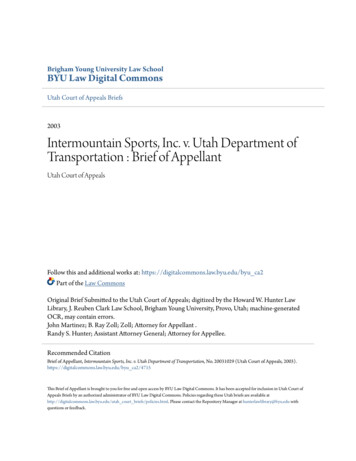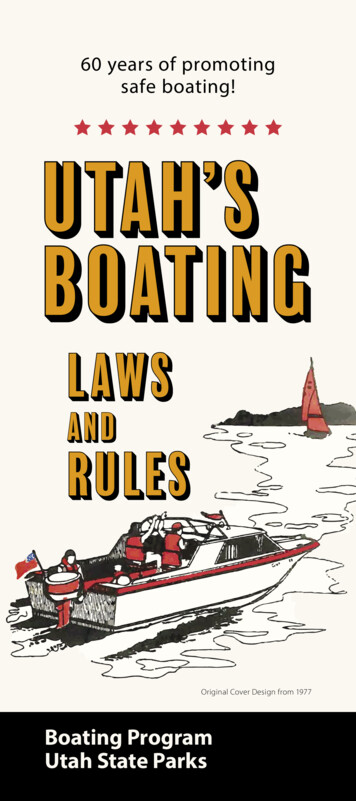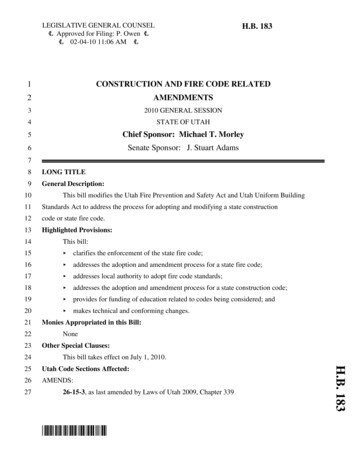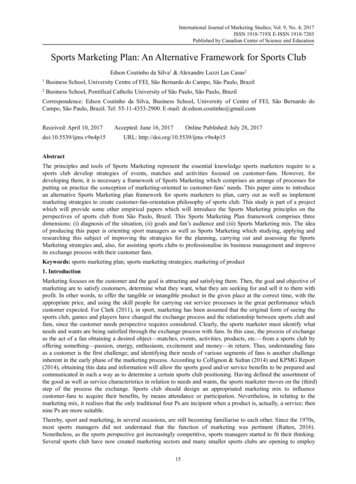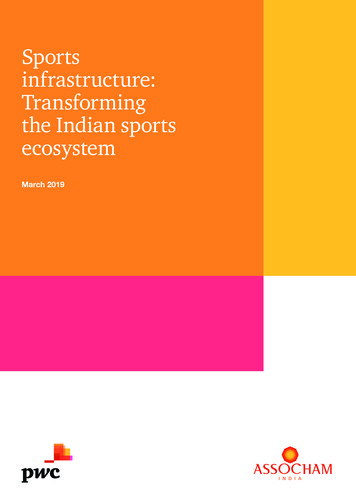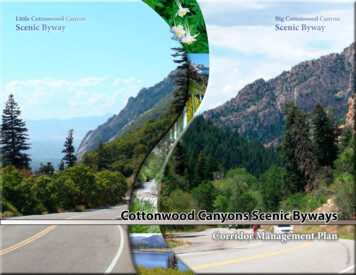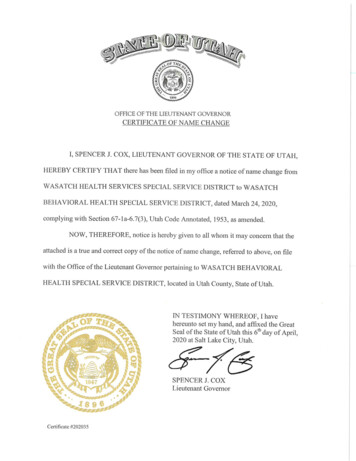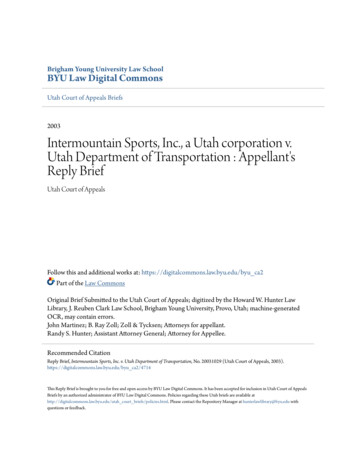
Transcription
Brigham Young University Law SchoolBYU Law Digital CommonsUtah Court of Appeals Briefs2003Intermountain Sports, Inc., a Utah corporation v.Utah Department of Transportation : Appellant'sReply BriefUtah Court of AppealsFollow this and additional works at: https://digitalcommons.law.byu.edu/byu ca2Part of the Law CommonsOriginal Brief Submitted to the Utah Court of Appeals; digitized by the Howard W. Hunter LawLibrary, J. Reuben Clark Law School, Brigham Young University, Provo, Utah; machine-generatedOCR, may contain errors.John Martinez; B. Ray Zoll; Zoll & Tycksen; Attorneys for appellant.Randy S. Hunter; Assistant Attorney General; Attorney for Appellee.Recommended CitationReply Brief, Intermountain Sports, Inc. v. Utah Department of Transportation, No. 20031029 (Utah Court of Appeals, 2003).https://digitalcommons.law.byu.edu/byu ca2/4714This Reply Brief is brought to you for free and open access by BYU Law Digital Commons. It has been accepted for inclusion in Utah Court of AppealsBriefs by an authorized administrator of BYU Law Digital Commons. Policies regarding these Utah briefs are available athttp://digitalcommons.law.byu.edu/utah court briefs/policies.html. Please contact the Repository Manager at hunterlawlibrary@byu.edu withquestions or feedback.
IN THE UTAH COURT OF APPEALSINTERMOUNTAIN SPORTS, INC.,a Utah Corporation,Plaintiff-Appellant,UTAH DEPARTMENT 9-CACourt and judge below:Third Judicial District, Salt Lake CountyJudge William B. BohlingAPPELLANT'S REPLY BRIEFAPPEALAttorney for Appellee:RANDY S. HUNTERAssistant Attorney General160 East 300 South, 5th FloorSalt Lake City, Utah 84114-0857Attorneys for Appellant:JOHN MARTINEZ (USBA #4523)2974 East St. Mary's CircleSalt Lake City, Utah 84108B. RAY ZOLL (USBA#3607)ZOLL & TYCKSEN, L.C.5300 South 360 West, Suite 360Murray, Utah 84123FILEDUTAH APPELLATE COURTS(Oral Argument and Published Decision Requested)JUN 21 2004
Pursuant to Utah Rule of Appellate Procedure 24(c), Plaintiff-Appellant IntermountainSports, Inc., (hereinafter "Appellant"), by and through its counsel of record John Martinezand B. Ray Zoll, hereby submits the following Reply Brief:TABLE OF CONTENTSPAGETABLE OF CONTENTSiiTABLE OF AUTHORITIESiiiARGUMENT1I. INVERSE CONDEMNATION CLAIM1A.Harm Caused by Inverse Condemnation is by Definition Unplanned,but is Nevertheless Compensable1B.Appellant Can Recover Even Though its Right to Use its Land Was NotTotally Destroyed2C.Appellant is Entitled to a Jury Trial3II. UNIFORM OPERATION OF LAWS CLAIM5A.The Uniform Operation of Laws Clause Provides a Private Rightof Action Because it is Self-executing5B.Damages are Available as a Remedy for Violation of the UniformLaws Clause7C.A Claim for Violation of the Uniform Laws Clause Does NotRequire a Statutory or Common Law Cause of Action9CONCLUSION10CERTIFICATE OF SERVICE11ii
TABLE OF AUTHORITIESUNITED STATES CONSTITUTIONU.S. CONST, amend. VU.S. CONST, amend. XIV, § 146UTAH STATE CONSTITUTIONUTAH CONST, art. I, § 27UTAH CONST, art. I, § 104,4UTAH CONST, art. I, § 22UTAH CONST, art. I, § 242, 35,6UTAH CODE ANNOTATEDUtah Code Ann. § 68-3-1Utah Code Ann. § 78-21-174UTAH RULESRule 24(c), Utah Rules App. ProciiCASESB.A.M. Development, L.L.C. v. Salt Lake County, 2004 UT App 34, 87 P.3d 710 . . . 3,4Carrier v. Pro-Tech Restoration, 944 P.2d 346 (Utah 1997)6, 7City of Monterey v. Del Monte Dunes at Monterey, Ltd., 526 U.S. 687,119 S.Ct. 1624 (1999)4Colman v. Utah State Land Board, 795 P.2d 622 (Utah 1990)-3Diamond B-YRanches v. Tooele County, 2004 UT App 1352, 2, 2, 2, 3Farmers New World Life Insurance Co. v. Bountiful City, 803 P.2d 1241 (Utah 1990) . 2International Harvester Credit Corp. v. Pioneer Tractor, 626 P.2d 418 (Utah 1981) . . 4Lee v. Gaufin, 867 P.2d 572 (Utah 1993)6Liedtke v. Schettler, 649 P.2d 80 (Utah 1982))7Lucas v. South Carolina Coastal Council, 505 U.S. 1003, 112 S. Ct. 2886 (1992)1Malan v. Lewis, 693 P.2d 661 (1984))6, 6Mountain Fuel Supply Co. v. Salt Lake City Corp., 752 P.2d 884 (Utah 1988))7Palazzolo v. Rhode Island, 533 U.S. 606 (2001)2, 2Pennsylvania Coal v. Mahon, 360 U.S. 393,43 S.Ct. 158, 67 L.Ed. 322 (1922)1Penn Cent. Transp. Co. v. City of New York, 438 U.S. 104 (1978)3, 3, 3, 3Pinetree Associates v. Ephraim City, 2003 UT 6, 67 P.3d 4626Richards v. Salt Lake City, 49 Utah 28, 161 P.680 (1916)4Spackman v. Board of Education of Box Elder County School District,2000 UT 87, 16 P.3d 5335, 6, 7, 7, 7, 8, 8, 8, 9, 9, 9, 9, 9, 9,10, 10Three D Corporation v. Salt Lake City, 752 P.2d 1321 (Utah Ct App 1988)1iii
ADDITIONAL AUTHORITIESProceedings and Debates of the Constitutional Convention (1898)iv1,4
AlUjilJIVmiNTI. INVERSE CONDEMNATION CLAIMUDOT does not appear to seriously dispute thai Appellant indeed sui icred v .omicharm liom IT)OT. reeonstruetior fT 1 * -ppdic*. * ;;. . .avoid paying lui .,./ .,.?'.,;, . . "*.u' -- * * \ ppcllanfb right toi .- h e \ppelloiii io „ul entitled to a jury trial. Each ofthese contentions will be addressed in turn.farm Caused by Inverse ( oiidemnatioiiNevertheless Compensable * t: nan for or pay for all losses caused by public:'xppellce'b Brief, pp.( -,". Justice holmes' response to that contention is a- ,]*,;today as when he uttered it in 1922 in the seminal case on inverse eomliitiifiatiOii:We are in danger oi lorgeumg u.-. pm/i. ACbiic io j.nprove the publiccondition is not enough to wan dm ». .;ie\ ing the desire by a shorter cut thanthe consfi'ntion-il way of nnvimr for the change.PennsyK ania Coal v. Mahon, 3oU U.s w .416, s r \ 1 58. Gn L . M 322 i . v . ,mscourt has acknowledged that principle is applk am.,.;., we. . UJV LI f it'ipoicu.w„ .Salt Lake Lit\'x* . ; '; n g Justice 1 lolmesj. »* '- -mpensation Clause \\ ere well aware that unintentionally-caused harm is compensable. Proceedings and Debates ofthe Constitutional Convention, 327(I 8 8)f'Damage i\s n-. * ahvavs-'-ir fi * 1'n not often aunit uikid lor as me conseqiu . t f rms.")(Samuel R. Thuiman),Opening bricl . ? *. Iiibit 4. And Utah law is clear that "Intent is not an element of1
[an inverse condemnation] action." Farmers New World Life Insurance Co. v. Bountiful City,803 P.2d 1241,1246 (Utah 1990)(interpreting UTAH CONST, art. I, §22).If a jury determines UDOT caused Appellant's economic harm, the state cannot avoidpaying for it on the ground that the state did not plan to do so.B.Appellant Can Recover Even Though its Right to Use its Land Was Not TotallyDestroyedUDOT misinterprets this court's decision in Diamond B-Y Ranches v. Tooele County.2004 UT App 135, 498 Utah Adv. Rep. 32 as standing for the proposition that a takingoccurs only when governmental conduct renders private land "economically idle." Appellee'sBrief, p. 14. On the contrary, this court emphasized in Diamond B-Y Ranches that a takingoccurs when there is:[denial of] all economically beneficial or productive use of land, or, even if theproperty has not necessarily been deprived of all economically beneficial use, ananalysis of several factors indicates that the interference is so great that a virtualtaking has nonetheless occurred.Id. 2004 UT App at [14, quoting Lucas v. South Carolina Coastal Council 505 U.S. 1003,1015, 112 S. Ct. 2886, 2893 (1992) and Palazzolo v. Rhode Island. 533 U.S. 606, 617, 121S. Ct. 2448, 2457 (2001)(emphasis added).This court recognized in Diamond B-Y Ranches, as did the United States SupremeCourt in Palazzolo, that partial takings are compensable. Therefore, a taking can be foundif either Appellant's right to use its land has been completely destroyed or if "an analysis ofseveral factors indicates that the interference is so great that a virtual taking [of Appellant'sright to use its land] has nonetheless occurred." Diamond B-Y Ranches v. Tooele County,2
2004 UT App at 14. Whether a partial taking has occurred depends on application of thePenn Central factors: "The economic impact of the regulation on the claimant and,particularly, the extent to which the regulation has interfered with distinct investment-backedexpectations . . . [and] the character of the governmental action." Diamond B-Y Ranches v.Tooele County, 2004 UT App 135, f 14, quoting Penn Cent. Transp. Co. v. City of NewYork, 438 U.S. 104, 124 (1978). This is the functional equivalent of the test for acompensable "taking" developed by the Utah Supreme Court under Utah's Just CompensationClause. UTAH CONST, art. I, §22; Colman v. Utah State Land Board, 795 P.2d 622,626 (Utah1990)(A "taking" is "any substantial interference with private property which destroys ormaterially lessens its value, or by which the owner's right to its use and enjoyment is in anysubstantial degree abridged or destroyed.")Appellant therefore can recover if it has suffered a partial taking of Appellant's rightto use its land.C.Appellant is Entitled to a Jury TrialUDOT contends that Appellant is not entitled to a jury trial. Appellee's Brief, p. 15.On the contrary, whether a taking has occurred in this case is a question of fact, andAppellant is entitled to have a jury decide that question.First, the application of the Penn Central factors to determine whether Appellant'sright to use its land was substantially impaired is a question of fact. In considering whetheran exaction in the land development setting constituted a taking, this court describedapplication of the Penn Central factors as a "fact-intensive inquiry." B.A.M. Development3
L.L.C. v. Salt Lake County, 2004 UT App 34, [109 87 P.3d 710. And in the analogous federalsetting, the United States Supreme Court has held that whether a landowner has beendeprived of economically viable use is a "predominantly factual question.11 City of Montereyv. Del Monte Dunes at Monterey. Ltd. 526 U.S. 687, 720, 119 S.Ct. 1624, 1644(1999)(construing federal Just Compensation Clause, U.S. CONST, amend. V).Second, Appellant is entitled to have a jury decide the factual question of whetherAppellant has suffered a taking. The drafters of the Utah Constitution fully intended that ajury would determine whether the state has committed a compensable taking. SeeProceedings and Debates of the Constitutional Convention ill(1898)(ff.the means ofarriving at the estimate are within the knowledge of men and can be adduced before ajury.f,)(Lorin Fair), Opening Brief, Addendum Exhibit 4. See also UTAH CONST. Art. 1, § 10(Trial by Jury); International Harvester Credit Corp. v. Pioneer Tractor, 626 P.2d 418 (Utah1981)(Utah Const. Art. I, §10 guarantees right to jury trial on legal issues in civil caseg);UTAH CODE ANN. §78-21-1 ("In actions for the recovery of specific reed or personal property,with or without damages, or for money claimed as due upon contract or as damages forbreach of contract, or for injuries, an issue of fact may be tried by a jury, unless a jury trialis waived or a reference is ordered."); Richards v. Salt Lake City, 49 Utah 28, 161 P. 680(1916)(whether road debris on private lot warrants compensation is a question for the jury).Appellant therefore is entitled to a jury trial on the question whether Appellantsuffered a taking from UDOTs reconstruction of 1-15.4
IL UNIFORM Q P E R A T I Q NQF L A W SC L A I MUniform Operation of Laws provision in the Utah Constitution provides no private right ofaction because it is not self-executing, and (2) that even if such a private right of action isprovided, damages are not available as a remedy for its violation. Appellee's Bi ic I, ll'» II6. s* requireseither a statutory or common law cause of action such as a negligence claim." hi. .\\ 1 ? [ hefirst two arguments lack merit and the third is a misinterpretation of the law.\The Uniform Operation of Laws Clause ProvidesBecause it is Self-executingVv n i l tof action is available under the Uniform Operation of Laws clausein the tah Constitution because it is a self-executing provision "that can be judiciallyenforced without implementing legislation." Spackman v. Board of Education of the BoxElder County School DistrictClauses held self-executing). Utah Constitutional clauses are judiciallyenforceable if (a) they are mandatory and prohibitory, (b) they are judicially definable andenforceable without enabling legislation and (c) the framers intended them to lake el I eelFirst, the Uniform Laws Clause provides: "All laws of a general nature shall haveuniform operation." UTAH CONST, ART. I, §24. *"TT 1constitutional clauses are"mandatory and prohibitory, unless by express words they ai e declared u ,x oilu r \\ i. 5-*' e „- . . :
meets the first requirement for a self-executing provision.Second, as with the Due Process and Open Education Clauses at issue in Spackman,although the Uniform Laws Clause is expressed in general terms, it has been carefullydefined and enforced by Utah courts many times, without implementing legislation. See, e.g.,Pinetree Associates v. Ephraim City. 2003 UT 6, % 17,67 P.3d 462 (assessment of thirty watercharges on condominium project while other users with only one meter were assessed onlyone monthly charge violated Uniform Operation of Laws); Lee v. Gaufim 867 P.2d 572, 577(Utah 1993)("For a law to be constitutional under Article I, section 24, it is not enough thatit be uniform on its face. What is critical is that the operation of the law be uniform."); Malanv. Lewis, 693 P.2d 661,669 (1984)(M[P]ersons similarly situated should be treated similarly,and persons in different circumstances should not be treated as if their circumstances werethe same."). The Uniform Laws Clause therefore is judicially enforceable without legislation.Third, the historical context in which the framers adopted the Uniform Laws Clauseclearly shows that they intended to constitutionalize existing concepts that did not requireimplementing legislation to become effective. Particularly significant is that the UniformLaws Clause embodies the same principles as the then-existing Equal Protection Clause ofthe Fourteenth Amendment of the United States Constitution. U.S. CONST, amend. XIV,§l(Equal Protection Clause); Malan v. Lewis, 693 P.2d at 669 (Uniform Laws and EqualProtection "embody the same general principle: persons similarly situated should be treatedsimilarly, and persons in different circumstances should not be treated as if theircircumstances were the same."); see also Carrier v. Pro-Tech Restoration, 944 P.2d 346,6
355- 56 (t Jtah 199 ] ) (troth clauses "embody the same general principles"); Mountain FuelSuppl) u . K . . . i j u . , or , 752 P 2 i 884: 888 ( [ Jl , tl I 1988) (s w im ); I iedtke v.Schettler. 649 P.2d 80, 81 n. 1 (Utah 1982)(Uniform Laws Clause is "generally consideredthe equivalent of the Equal Protection Clause of the 14th Amendment, IJ.S. Constitution")In fact, the founders reiterated in Article I, Section 2, that the people , i Utah are guaranteedtl le "eqi ml protection" : f theii state go\ ei in i i.e i it I I I A HCoi JS I ai I: I § 2. "The Uniform Laws Clause therefore is self-executing and hence creates a private rightof action for its enforcement.B.Damages a r e Available as a R e m e d y for Violation of the Uniform L a w s ClauseIlie Spacknian division emphasized tlul Ihe nx .lilnhililv ml diinuii'es ns a rnnoJv linna constitutional violation is analytically distinct from whether a constitutional provision isself-executing. Spackman v. Board of Education of the Box Elder County School District,2000 1 1 1 8 7, i it "11 ' 1 " I he i : i n I held 1 hat ; since C Jl i ill Cc de Seel ion 68-3 1 adopts 1 hecommon law individuals could obtain damages for violations of their rights enumerated infundamental documents which were the forerunners of our state and federal constitutions,iumages- uconstitutional provision rests on the common law." Id. at f20.The Spackman decision went on to describe the three elements required for Appellantto obtain damages for UDOT's violation of Appellant's right to Uniform Laws, each of which\ ppellant cai I estat lisl I: I "lii st, , Appellant's complaint must sufficiently allege a "flagrant"7
violation of its constitutional rights. Spackman, at [23. Appellant alleged it was not providedwith accommodations to alleviate the impact of the 1-15 reconstruction which were providedto other similarly situated businesses. (R. 6, Opening Brief, Addendum Exhibit 3, f26).Appellant further alleged that ". UDOT . discriminated against Plaintiff in violation ofArticle I, Section 24 of the Utah Constitution, by among other things, arbitrarily andcapriciously providing [those other similarly situated] businesses" with accommodations notprovided to Appellant—including diversion of traffic to provide such businesses withcontinued access to the 45th South offramp—and that such discriminatory treatment was"unreasonable and . not for a legitimate legislative purpose." (R. 10, Opening Brief,Addendum Exhibit 3, 1fl[39, 40). Such allegations sufficiently state a claim for a flagrantdenial of the right to uniform operation of laws.Second, Appellant must have no existing remedies to redress its injuries. Spackman,at [24. UDOT has not identified any remedy otherwise available to Appellant. On thecontrary, UDOT has strenuously contended throughout this litigation that Appellant has noremedy whatsoever.Third, equitable relief, such as an injunction, must be wholly inadequate to protectAppellants rights or to redress its injuries. Spackman, at f25. Appellant does not contend that1-15 should not have been rebuilt, but only that UDOT should not have treated Appellantdiscriminatorily, in violation of Appellant's right to Uniform Laws. Accordingly, equitablerelief, such as an injunction, was wholly inadequate both at the time of the 1-15reconstruction and today.8
Damages therefore are available as a remedy for violation of the Uniform Lawsentitled to damages "depends on the application of the analysis . to the particularcircumstances of the case." Spackman, at 27. That determination is for the juiy on remand.C.A Claim for Violation of the Uniform Laws Clause Does Not Require a Statutoryor Common Law Cause of ActionI JDOT contends tl lat Spademan stai ids for the pi opositionthat' '[a] claim foi * - iolationof a state constitutional right requires either a statutory or common law cause of action suchas a negligence claim.'1 Appellee's Brief, \1cTTDOT go* on U atmic (hat \ppellant "isunable to point to an express creation of a private cause of actionUDOT's reading of Spackman woi lid n lake the ca-"'- ' ilissue in the case was whether the Uniform Laws Clause itself provided a pn\ ak, right ufaction. The court held that it did. Nowhere in the opinion does the court suggest that aseparate, independent source of r ight ' is necessary,X JDOT goes astray, it apjvan;, in Ms mlnpidatslatcm-/ path. nan that"a \ Jtah court's ability to award damages for violation oi a self-executing constitutionalprovision rests on the common law." Appellee's Brief, pp. 15-16, quoting Spackman, at f20.courts in Utah have power as institutions to award damages for state constitutional \ iolationsthat are held to be self-executing. The source of that power is the common law of England.Once having made that determination, the court went on to define the elements a trial court"M Ijinagc.-.o-lai., n in any particular case.
Spackman, at f22. At no time did the court say that a claimant needed anything more.In summary, the Spackman case establishes that the right to be free fromdiscriminatory treatment is embodied in the Uniform Laws Clause. Discriminatory treatmentin violation of the Clause by itself gives rise to Appellant's right to relief.CONCLUSIONThis Court should reverse the final judgment by the trial court and remand the casefor further proceedings. UDOT should be taxed with costs on appeal.DATED this 21st day of June, 2004.10
CERTIFICATE OF SERVICEFiled eight copies of the foregoing, one containing an original signature, as wellas a CD containing an electronic version of the same in WordPerfect format, with the Clerkof the Utah Court of Appeals:OFFICE OF THE CLERK OF THE COURTUTAH COURT OF APPEALS450 SOUTH STATE STREET, FIFTH FLOORSALT LAKE CITY, UTAH84114-0230and served two copies of the foregoing upon the following:Attorney for Defendant Utah Department of TransportationRandy S. HunterAssistant Attorney General160 East 300 South, 5th FloorSalt Lake City, Utah 84114-0857via first class mail, postage pre-paid, this 21st day of June, 2004, addressed as set forthabove. .HI ! * *r
JOHN MARTINEZ (USBA #4523) 2974 East St. Mary's Circle Salt Lake City, Utah 84108 B. RAY ZOLL (USBA#3607) ZOLL & TYCKSEN, L.C. 5300 South 360 West, Suite 360 . Farmers New World Life Insurance Co. v. Bountiful City, 803 P.2d 1241 (Utah 1990) . 2 International Harvester Credit Corp. v. Pioneer Tractor, 626 P.2d 418 (Utah 1981) . . 4

